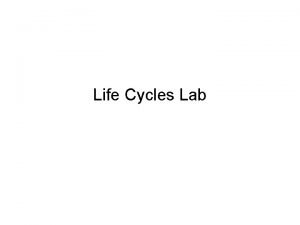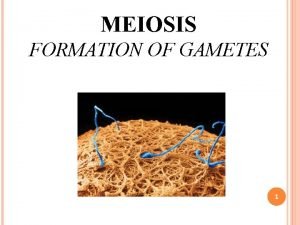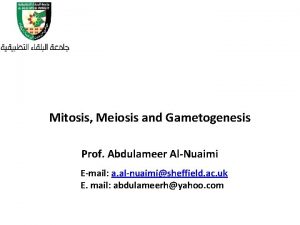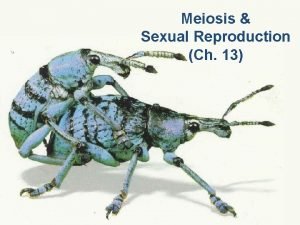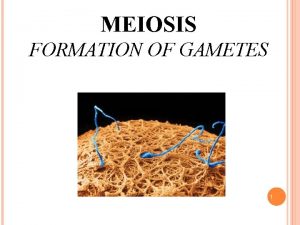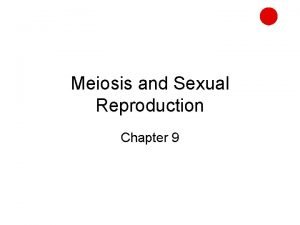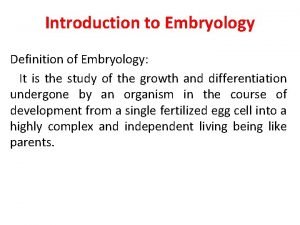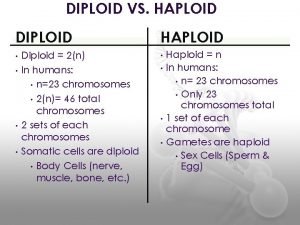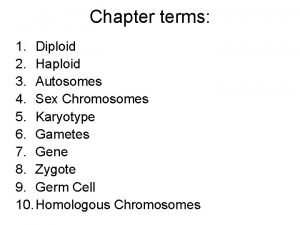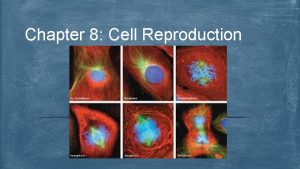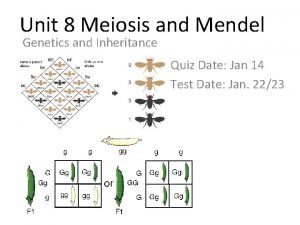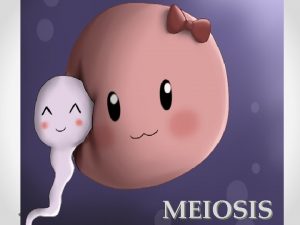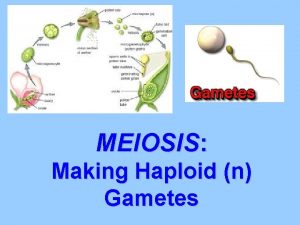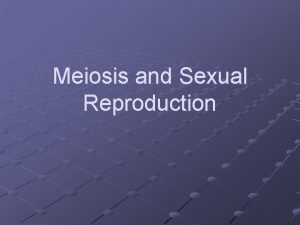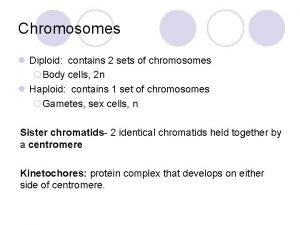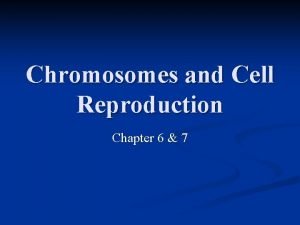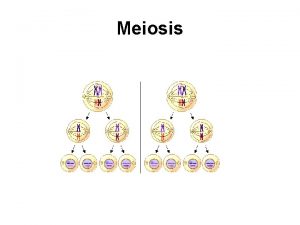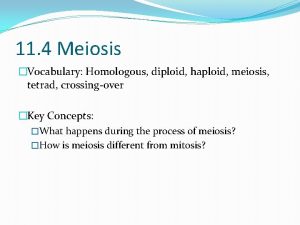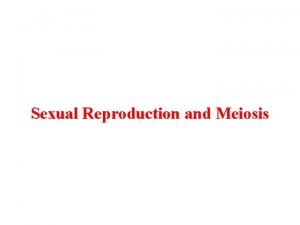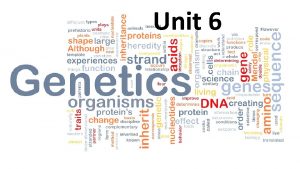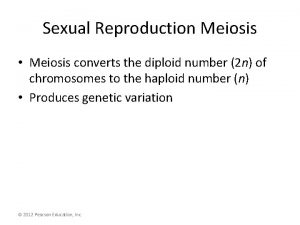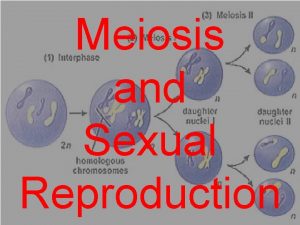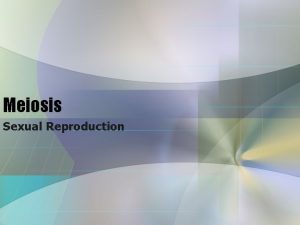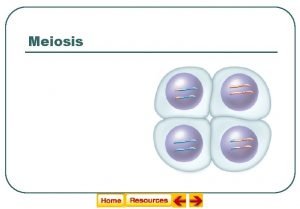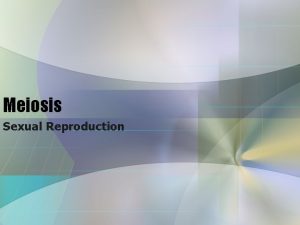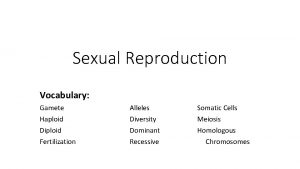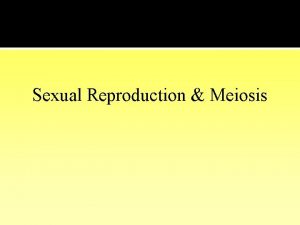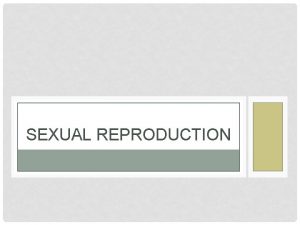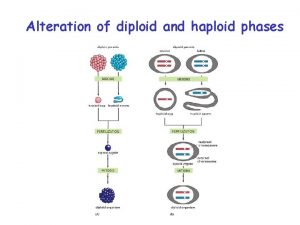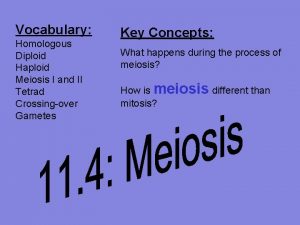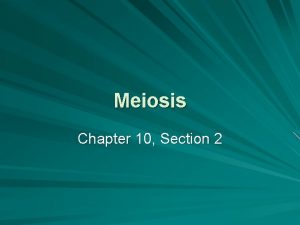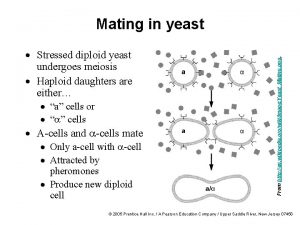Meiosis and Sexual Reproduction Diploid and Haploid chromosomes



























- Slides: 27

Meiosis and Sexual Reproduction

Diploid and Haploid chromosomes numbers n n n Somatic cells are all cells of an organism that are not involved in reproduction. Human somatic cells have 46 chromosomes (23 pairs). The chromosomes that make up each pair are called homologous. Cells which have all the homologous chromosomes are Diploid Cells which have only one chromosome from the pair are Haploid. Gametes are reproductive cells. They are haploid.

Advantages of sexual reproduction n n In asexual reproduction there are no variations. In sexual reproduction the offspring are not identical to the parents genetically. It generates increasing amount of diversity and variation. It helps species to adapt better to their environment.

Conjugation n n In protists and simple organisms (bacteria). No distinctive gender, but some mating types + and -. In conjugation a bridge of cytoplasm is formed between two cells and nuclear material is exchanged. In bacteria, there is a donor and a recipient of DNA.

Conjugation in Spirogyra n n n Spirogyra is a green algae. Active and passive are the genders. Formation of a conjugation tube between the cells The original cells are haploids and after conjugation a zygospore is formed. The zygospore is diploid and undergoes meiosis. Only one cell from the meiosis survives and forms a new filament of algae.

Conjugation in Paramecia n n Plus and Minus mating type. They stick together by their oral groove Protoplasmic bridge forms between them. Haploid micronucleus moves in the protoplasmic bridge to the other paramecium

Sexual Reproduction in Animals n Reproductive systems: n n n The sex of an individual might be identified by physical appearances. Gametes of animals develops in Gonads. Female gonads are ovaries. They produce egg cells or Ova. The male gonads are testes: they produce sperm cells. Hermaphrodism: the sexes are not separate. n n n Individuals have both testes and ovaries. Snails, hydra, earthworms. Rare self-fertilization.

Phases of Meiosis








Crossing Over/ Recombination n Happens during Prophase I Synapsis is the process of linking of the replicated homologous chromosomes The resulting chromosome is termed a tetrad, being composed of two chromatids from each chromosome, forming a thick (4 -strand) structure

Gametogenesis n n Females: Oogenesis. Males: spermatogenesis.





Comparison of egg and sperm n n Egg is round and unable to move. Contains the nucleus and large amounts of stored food. Some eggs contain yolk. Sperm cells are microscopic. Made up of head, middle piece and flagellum. The head is made up of the nucleus and an acrosome. The middle piece contains mitochondria. The flagellum allows the sperm to swim through liquids.



Fertilization n External fertilization: the eggs are fertilized in an environment outside of the female body. The only sex organs needed are ducts to guide the eggs and sperm cells out of the body. Fertilization takes place in the water, where the sperm cells swim to meet the egg. (spawning, frog amplexus) Internal fertilization: prevents scattering of gametes. Fertilization inside the female. Requires a specialized sex organ. The fertilized egg is released in a shell or remains inside the female’s body. Parthenogenesis: formation of an egg without fertilization.


 2n=2 meiosis
2n=2 meiosis What is haploid and diploid
What is haploid and diploid Diplod
Diplod How are mitosis and meiosis similar
How are mitosis and meiosis similar Diploid and haploid
Diploid and haploid Asexualk
Asexualk Prophase 2
Prophase 2 Primary oocyte haploid or diploid
Primary oocyte haploid or diploid Metaphase mitosis
Metaphase mitosis Primary oocyte haploid or diploid
Primary oocyte haploid or diploid Advantage of sexual reproduction
Advantage of sexual reproduction Parthenogenese
Parthenogenese Nucleus of primary oocyte
Nucleus of primary oocyte Diploid vs haploid number
Diploid vs haploid number Diploid vs haploid
Diploid vs haploid Cell with 4 chromosomes
Cell with 4 chromosomes Haploid vs diploid
Haploid vs diploid Genotype vs phenotype ratio
Genotype vs phenotype ratio Anaphase 2
Anaphase 2 2n haploid or diploid
2n haploid or diploid Sexual reproduction and genetics section 1 meiosis
Sexual reproduction and genetics section 1 meiosis Sexual reproduction and genetics section 1 meiosis
Sexual reproduction and genetics section 1 meiosis Venn diagram of sexual and asexual reproduction
Venn diagram of sexual and asexual reproduction Asexual vs sexual reproduction venn diagram
Asexual vs sexual reproduction venn diagram Number of chromosomes in haploid cells in a king crab
Number of chromosomes in haploid cells in a king crab Diploid contains 2 sets of chromosomes
Diploid contains 2 sets of chromosomes What are haploid cells
What are haploid cells Chapter 6 chromosomes and cell reproduction
Chapter 6 chromosomes and cell reproduction


